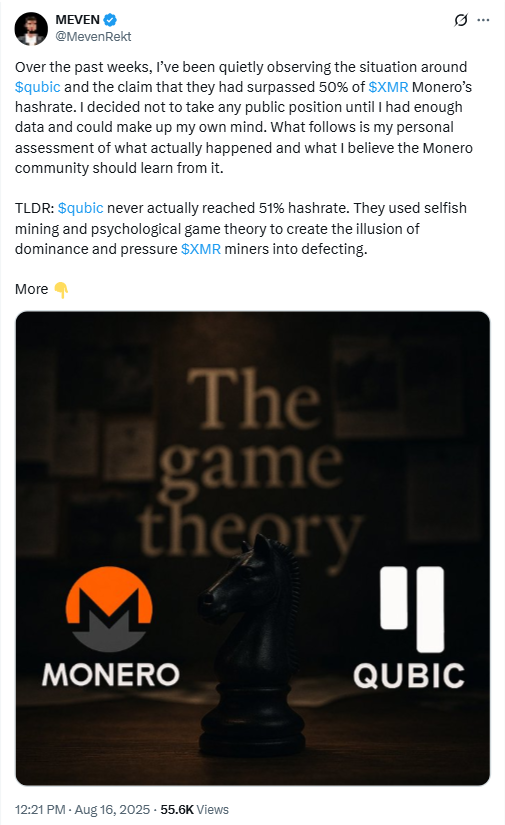Monero Under Siege: Kraken Halts Deposits Amid 51% Attack Fears—Is Your XMR Safe?
Monero's vaunted privacy meets its stress test as Kraken freezes deposits—proof-of-work's dirty secret rears its head again.
When 'decentralized' meets 'disaster'
The exchange's cold feet reveal crypto's eternal paradox: the chains meant to bypass bankers still kneel to miner majorities. A 51% attack isn't just protocol failure—it's a $2.8B network begging for institutional custody solutions (irony noted).
Meanwhile, bagholders rationalize: 'It's not a flaw, it's a feature!' as their beloved XMR dances on the knife-edge of Nakamoto consensus. Stay tuned—the next episode of 'Crypto Soap Opera' airs right after this brief message from our sponsors: centralized exchanges.

Kraken Exchange has stopped Monero deposits after one mining pool was believed to control over 50% of the network’s power.
The exchange said the pause was a security step as fears of a 51% attack raised questions about the stability of the cryptocurrency.
Kraken Acts to Safeguard Monero Users
Crypto exchange Kraken paused Monero (XMR) deposits after detecting a high concentration of mining power in a single pool.
According to the update, the exchange said this posed a possible threat to the security of the network.
The announcement noted that deposits WOULD be restored only when it was safe to do so. Trading and withdrawals were not affected.
The action came after reports that a mining group known as Qubic had gained over half of Monero’s total hashrate.
With this concern, the group could exercise enough control to carry out a 51% attack. That would allow it to alter or block transactions.
This type of event is one of the biggest risks facing proof-of-work blockchains.
Qubic stated publicly that it had already reached this point and warned that miners outside its pool could see their blocks rejected.
The group urged them to switch to its pool to avoid losing profits. This message was seen as an attempt to pressure other miners and create a sense of fear.
Independent data, however, told a different story. At the time, Qubic’s share was measured between 35, and 38% of the total network power, not more than half.
In some short periods, the group mined more than half of the blocks. However, this was due to selfish mining techniques.
In selfish mining, blocks are withheld and then released at chosen times. This can make it seem as if the pool has greater control than it really does.
The 51% Attack Threat Explained
It is worth noting that 51% attack happens when one miner or group controls most of the network’s power.
Notably, with that level of control, they could reorganize the chain and carry out double-spending.
In Monero’s case, the real risk was not just technical, but also psychological. This is why observers described the situation as one shaped by game theory.

If honest miners stayed with their pools, Qubic remained in the minority. However, if miners believed others would defect, they might MOVE too, giving Qubic the strength it claimed to have.
The danger came from how miners reacted to the perception of control.
An audit carried out over one day showed that out of 699 blocks, 250 were linked to Qubic, equal to about 35.7%.
Analysts also noted that Monero’s overall hashrate ROSE by about 50%, showing that Qubic likely added new power to the network.
This made the claim more believable, even though the group never actually crossed the 50% line.
What This Means for Monero
It is important to add that the episode raised questions about the future security of Monero.
Members of the community called for stronger coordination among miners so that decisions would be based on verified data, not public claims.
Others suggested more support for solo-mining and P2Pool, which would help spread out the hashrate more evenly.
Some also said it may be time to discuss whether Monero’s RandomX mining system should be changed.
While RandomX makes it easy for many types of hardware to mine, it also allows large groups to redirect power quickly.
Possible updates could include penalties for delayed block sharing and changes to difficulty rules that would make selfish mining less useful.
Monero was not taken over, but the incident showed that even without majority power, a coordinated pool could still disrupt the system.
For now, Kraken has kept trading and withdrawals open, but deposits will stay paused until there is greater confidence in the network’s stability.

